This post may contain affiliate links. Please read our disclosure policy.
Learn how to make soft water cake topped with sweet and savory chai poh (preserved turnip) toppings and served with homemade spicy sambal sauce you will absolutely love.
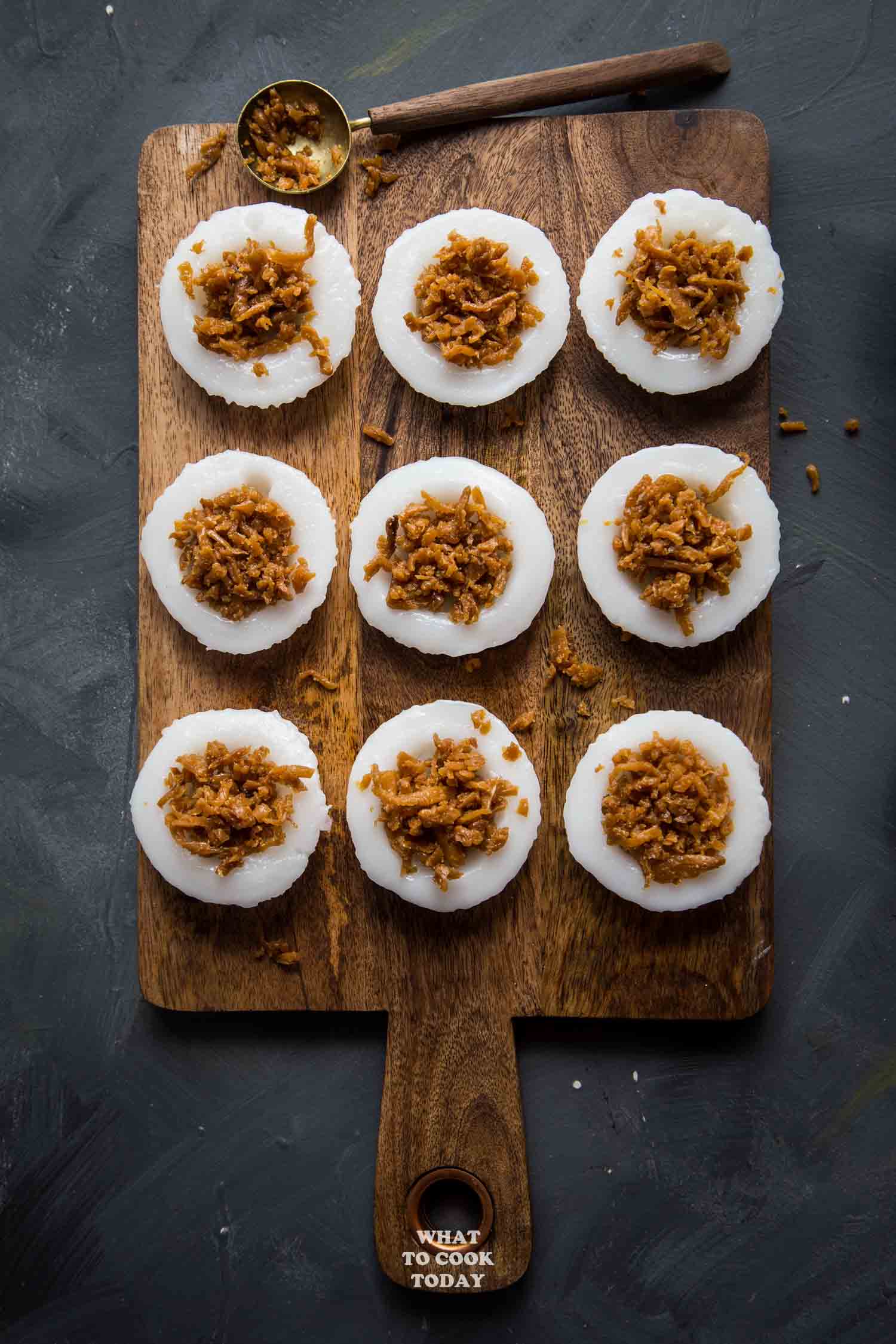
Soft Chwee Kueh (Water Cake with Chai Poh / Preserved Turnip)
WHAT IS CHWEE KUEH?
I came to know about this popular breakfast dish called Chwee Kueh (Steamed Water Rice Cake with Preserved Turnip) when I lived in Singapore for a short while. Chwee kueh or 水 粿 literally means “water cake” and hence in Hokkien dialect, they are called chwee, means water and kueh from Malay language means cake. This popular breakfast food is of Teochew origin.
Chwee kueh is made of water, rice flour, and combination of other gluten-free flour such as tapioca flour, wheat starch (not all-purpose flour), and cornstarch. The cakes were then steamed. They are soft and almost pudding-like in texture. This cake has a “dimple” on top and usually top with savory and sweet chai poh topping and then served with sambal chili.
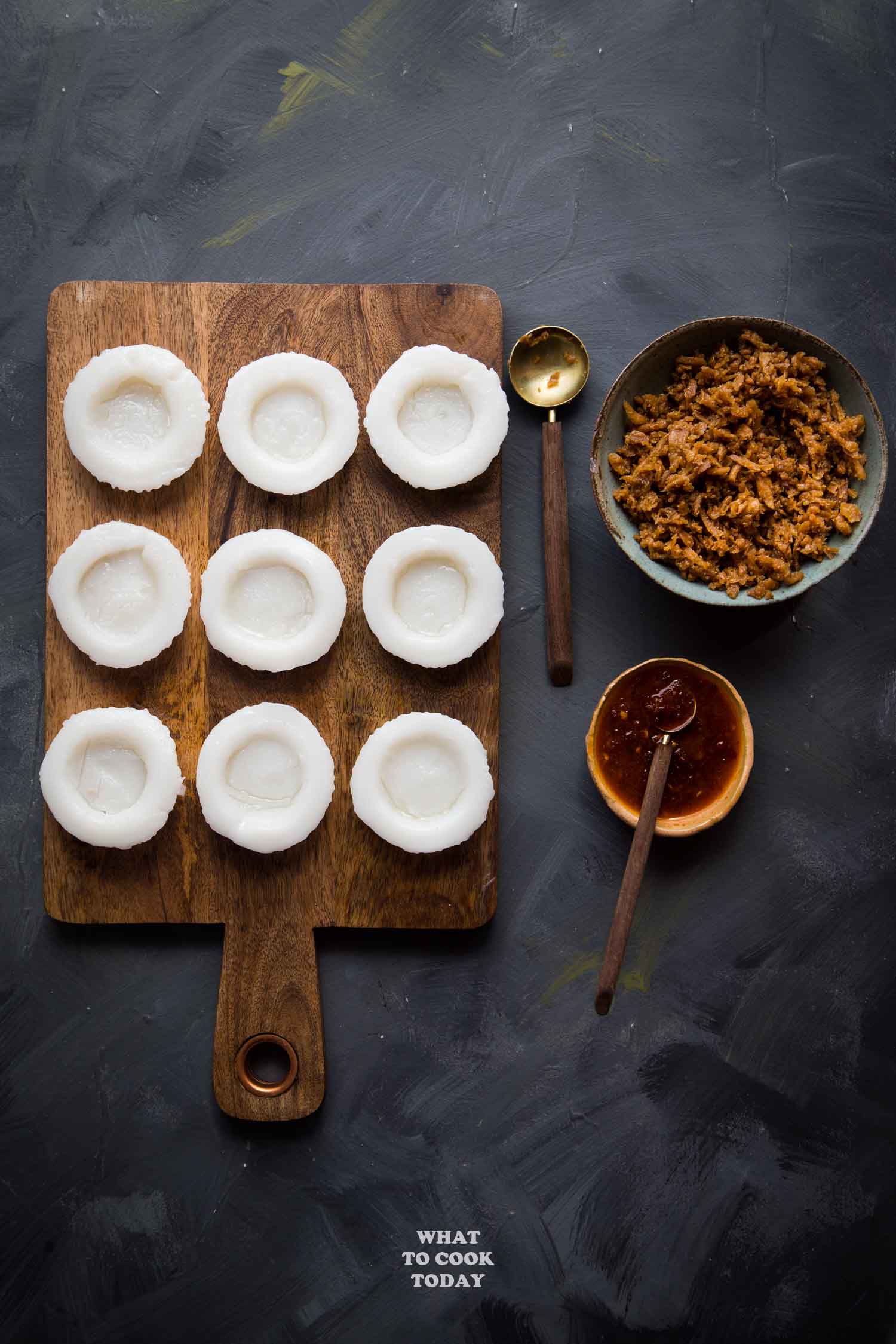
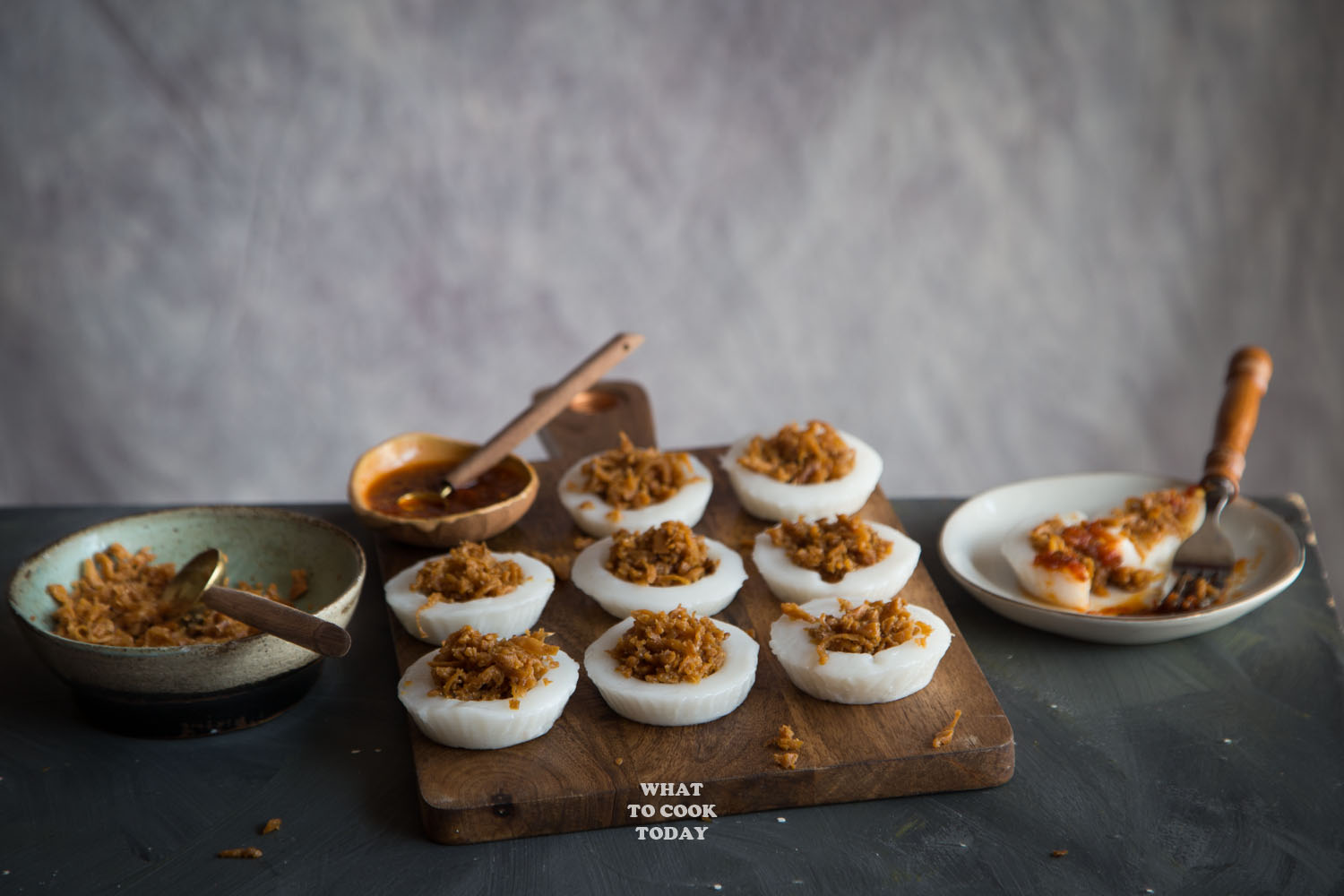
WHY IS THERE DIMPLE IN THE MIDDLE OF CHWEE KUEH?
Chwee kueh batter is very thin and when being steamed the water will “ooze” out and sit in the middle of the cake creating the dimple. This is one of the characteristics of chwee kueh and henced is named as such

Chwee Kueh after steaming- with dimple in the middle
WHY YOU’LL LIKE THIS CHWEE KUEH RECIPE
1. NO COOKING OF THE BATTER NEEDED
Most recipes for chwee kueh require that you cook the batter on the stove until it thickens slightly. Not with this recipe.
2. THE CAKE IS SOFT
I’ve been playing with different flour combinations (details below if you read on) and the amount of the water to yield soft chwee kueh
3. THEY ARE NATURALLY GLUTEN FREE
If you are looking for a gluten free chwee kueh recipe, this will definitely fit your bill
TWO DIFFERENT FLOUR COMBINATIONS YOU CAN CHOOSE (BOTH ARE EQUALLY GOOD)
Rice flour and water are the main ingredients in chwee kueh. Rice flour contributes to the softness of the cake The other type of flours added help to give the chwee kueh its’s slightly bouncy texture and cakes that resist tear.
FIRST VERSION
Flour combinations: Rice flour + Tapioca flour
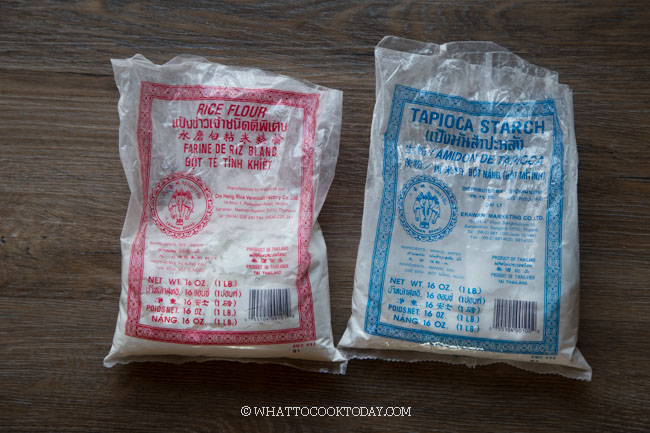
rice flour and tapioca starch
SECOND VERSION:
Flour combinations: Rice flour + Wheat Starch (not all-purpose flour) + Cornstarch

rice flour, wheat starch, cornstarch
WHICH VERSION IS BETTER?
I put hubby and the two kids to chwee kueh blind test and they couldn’t really tell the difference between the two versions in terms of softness and overall texture. They like both equally. So, I guess you can try them out and let me know if you think any differently.
IF YOU DON’T HAVE CHWEE KUEH MOULD
The traditional way of steaming chwee kueh is by using a shallow metal cups that are commonly found in Southeast Asia for steamed cake and this is especially for chwee kueh. I don’t have those cups. But fret not people. If you miss them so much and you are far away from home, you can still make chwee kueh using mini muffin cups like this or this 😉 They turn out perfect!!!

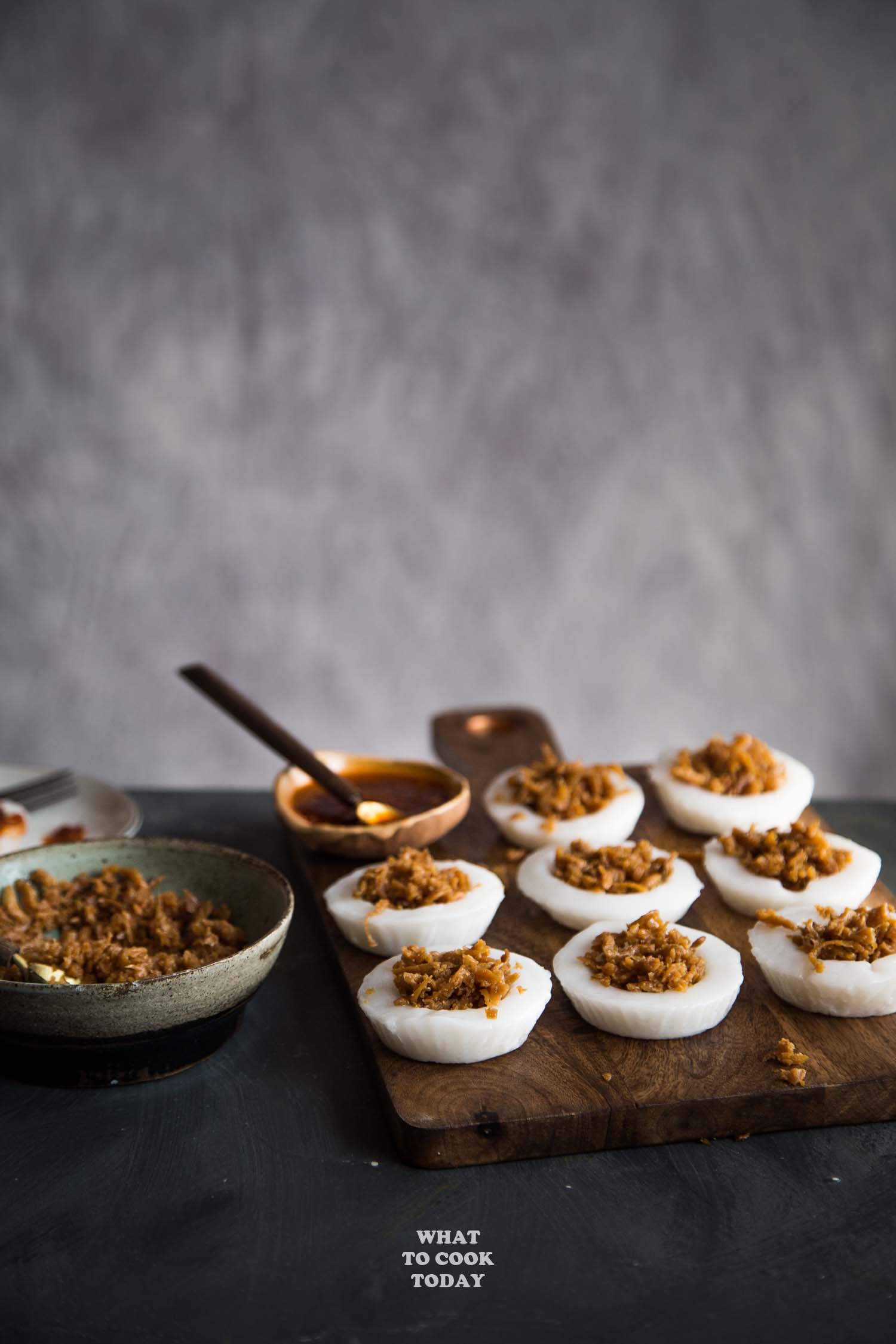
HOW TO MAKE CHAI POH TOPPING FOR CHWEE KUEH
1. I used sweetened chopped chai poh. Though they are sweetened, they still need to be rinsed to get rid of excess saltiness

Chai Poh
Rinse the chai poh in several changes of water or you can soak them in water for 4-5 minutes and then drain off water and squeeze out excess water
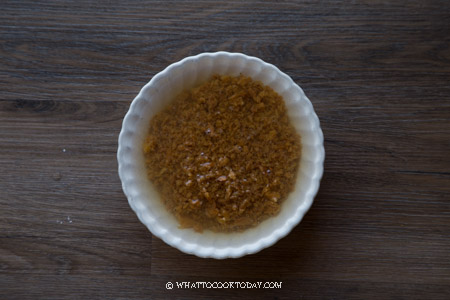
2. Heat 2 Tbsp of cooking oil in a wok/skillet. Stir-fry shallots until soft, about 2 minutes. Add garlic and stir fry for another 30 seconds.

3. Add chopped preserved radish along with seasonings and stir-fry until fragrant and dry.
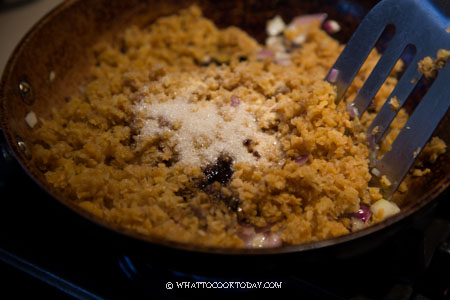
4. Have a taste. It should be sweet and slightly salty. Add more sugar as needed
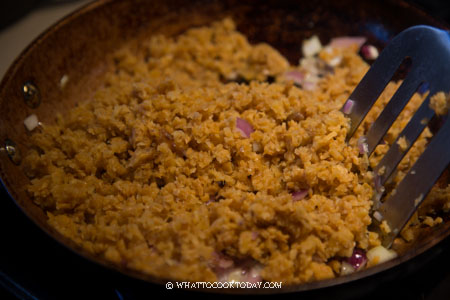
HOW TO MAKE SOFT CHWEE KUEH
1. Bring water to a rolling boil and then wait for 15 minutes before mixing into the batter (it is important not to skip this part-read explanation in recipe)
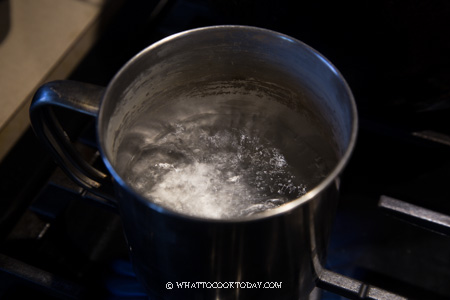
3. While waiting for the water to cool down, mix all flours with room-temperature water, oil, and salt. The batter will be thick at this point
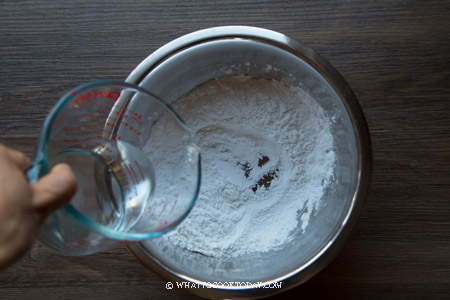
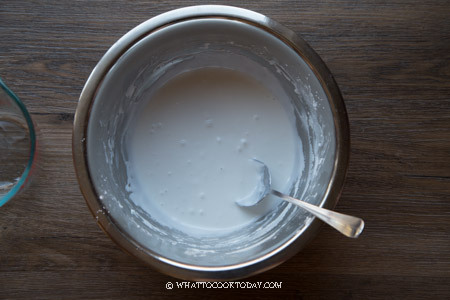
3. Make sure your steamer is ready to steam. As the batter can’t be sitting around for too long waiting for the steamer to get ready. Bring water to a rolling boil when it’s close to time to pour in the slightly cooled-down boiling water
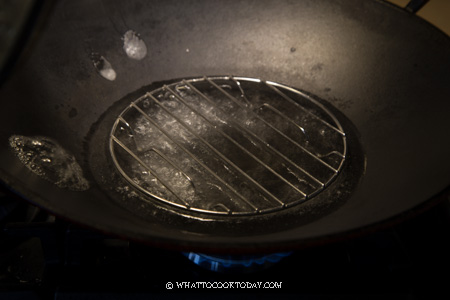
4. Brush the chwee kueh moulds or cups lightly with some cooking oil
5. Then add the boiled water that has been cooled down for 15 minutes into the batter and stir until you have smooth thin batter
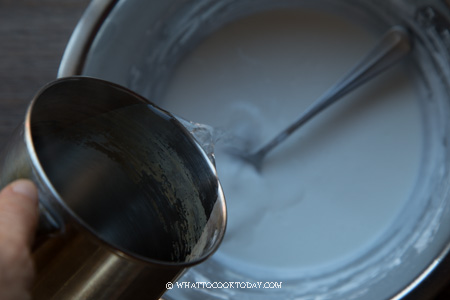
6. Steam the empty cups/muffin cups in the steamer over high heat for about 1 minute
7. Then pour this into the cups/muffin cup, about 3/4 full and then steam immediately on high heat for 15 minutes for small cakes and 20 minutes for larger cakes. Then uncover and let the steam without a lid for another 2 minutes to “dry up” the liquid that pools in the middle of the cake
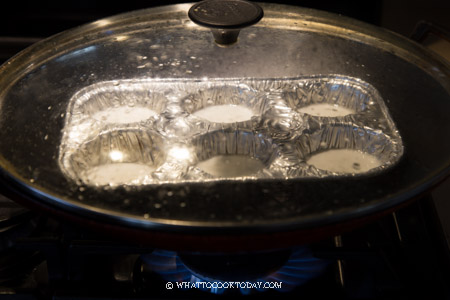
8. Let them cool down for 10 minutes before unmoulding
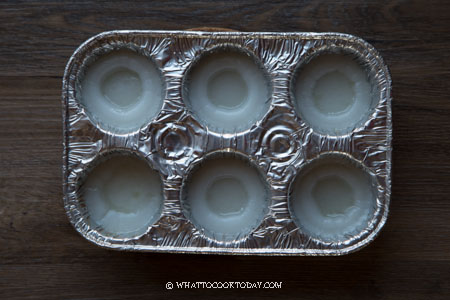
9. Unmould the chwee kueh with mini spatula or a toothpick to wedge it out
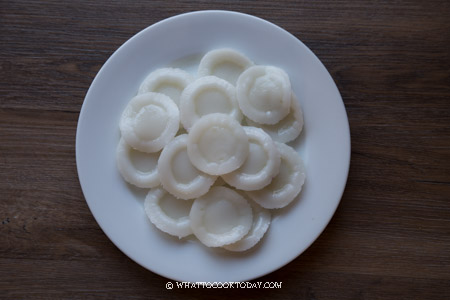
8. Top with preserved turnip topping and served with sambal
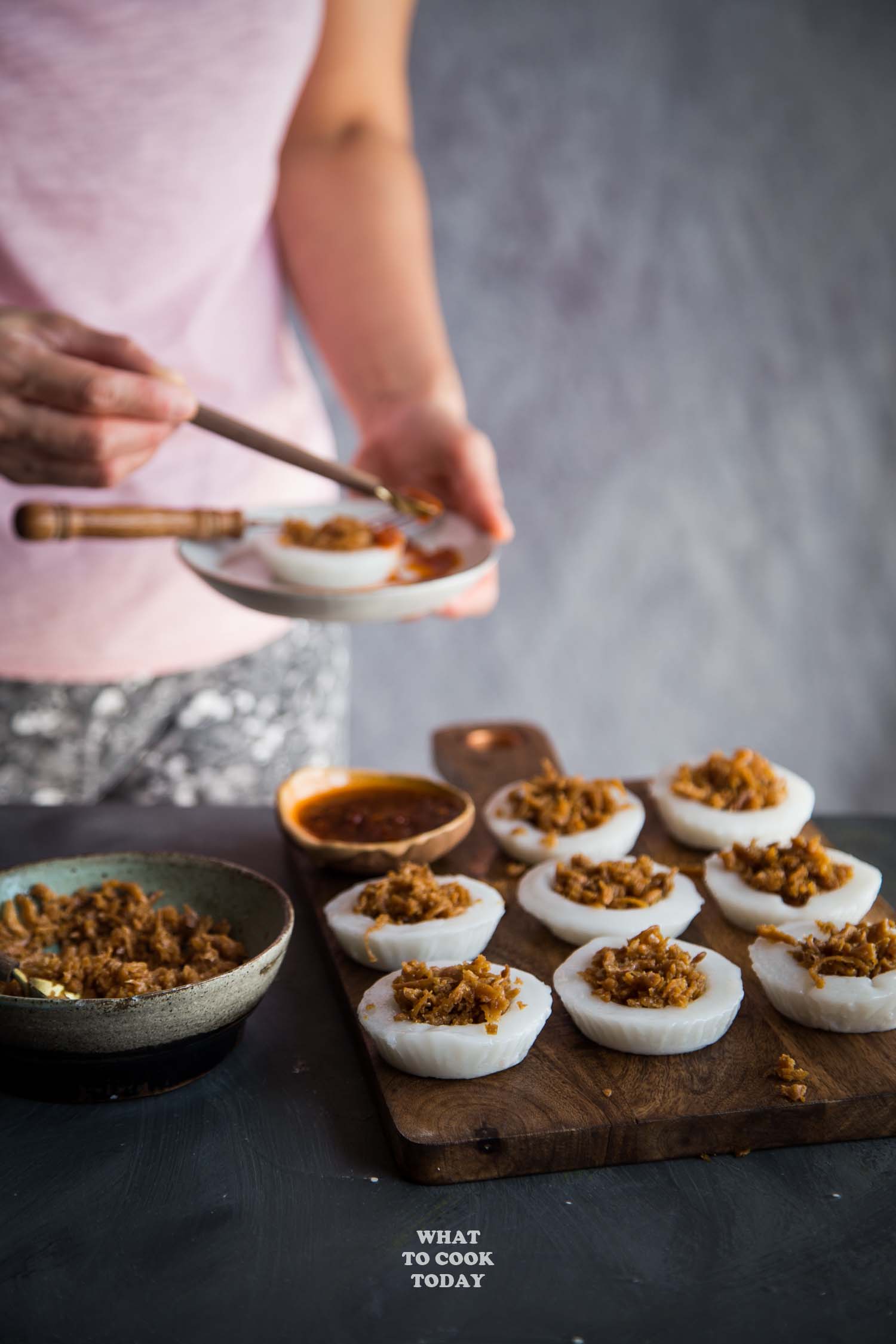
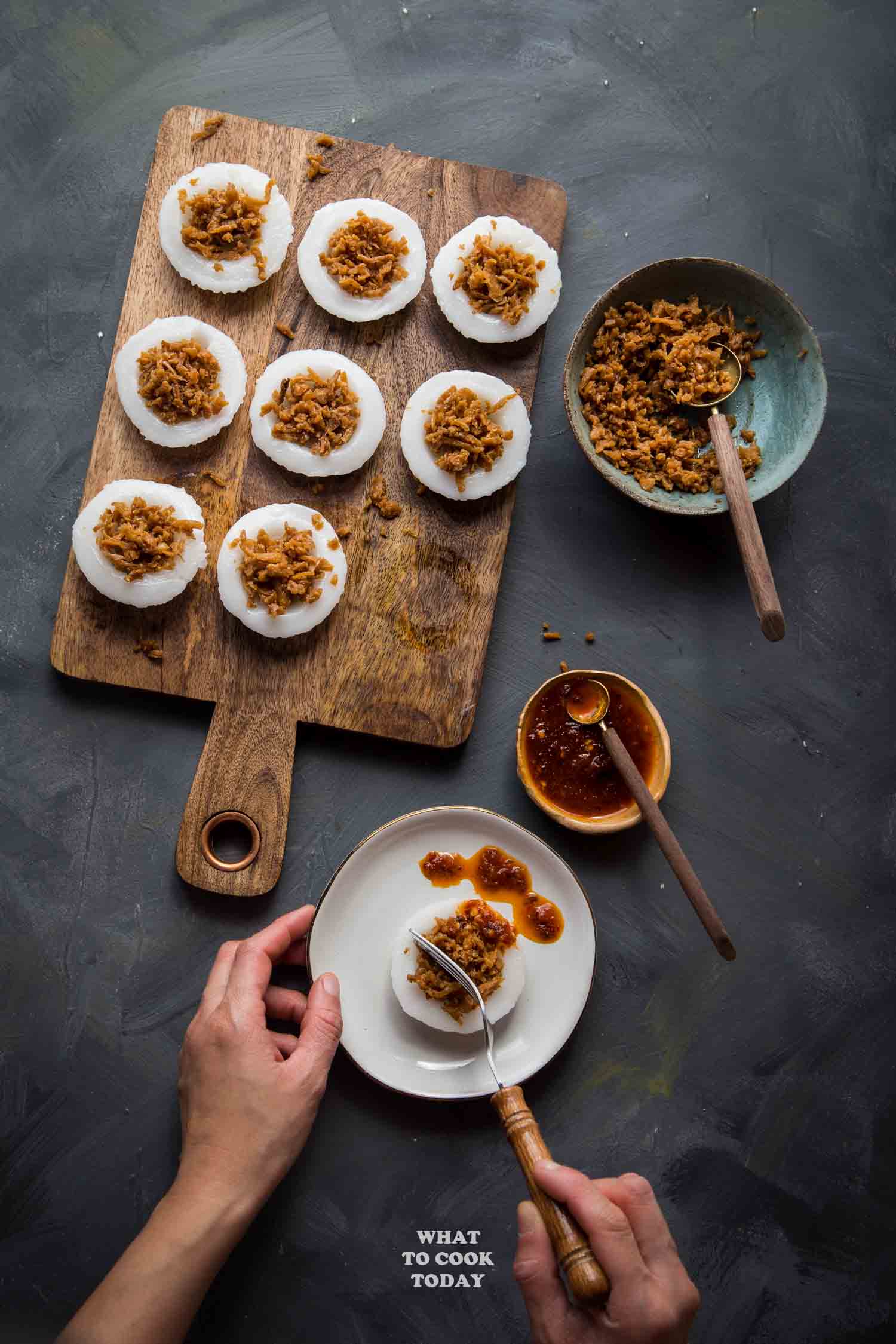
IMPORTANT TIPS
1. Make sure you steam the empty cups or muffin cups before pouring the batter
2. Gives the batter a stir each time before you pour into the cups
3. Make sure the water in the steamer is on a rolling boil and you steam over high heat
4. Definitely let them cool down, for about 10 minutes before unmoulding from the cups
CHWEE KUEH SEEMS UNCOOKED
The cake will still appear to be very soft (you almost think that it’s not cooked through) and with some water pooling in the middle, that’s normal and don’t be alarmed. Let them cool down for at least 10 minutes. The water that pooled in the middle will dry up too as they cool down

*Recipe was originally published in 2012 and has been updated to improve the recipes and to include 2 different versions. The second version was adapted from here with slight modification. Steaming time has also been updated. The chwee kueh has been tested again on April 30, 2020 and measurements for liquid and flour are accurate as written in the recipe.*
Chwee Kueh (Water Cake with Chai Poh / Preserved Turnip)
Ingredients
Version 1 (Rice flour + Tapioca flour):
- 150 gr rice flour
- 25 gr tapioca flour
- ¼ tsp salt
- 200 ml water room temperature
- 600 ml boiling water (Bring to a boil & leave for 15 mins)
- 2 tsp cooking oil
Version 2 (Rice flour + Wheat starch + Cornstarch):
- 150 gr rice flour
- 12 gr wheat starch not all-purpose flour
- 12 gr cornstarch
- ¼ tsp salt
- 100 ml water room temperature
- 500 ml boiling water (Bring to a boil & leave for 15 mins)
- 2 tsp cooking oil
Topping:
- 150 gr sweet chai poh (preserved turnip) or mixture of both sweet and savory chai poh
- 2 Tbsp cooking oil
- 3 shallots finely chopped
- 2 cloves garlic finely chopped
- 1 Tbsp dark soy sauce
- 2 Tbsp sugar more as needed
- ½ tsp fresh ground white pepper
Serve with: Sambal chili
- ½ recipe chili paste
- 1 Tbsp sugar
- ½ tsp salt
Helpful tools:
- mini spatula
- individual mini cups
Or you can this if you don't have the cups:
Instructions
Prepare the sambal chili:
- You can make a full recipe or half recipe of this chili paste (chili boh). I use this chili paste as a base for many of my other sambal chili. When you stir fry it on a pan, you don't need anymore oil. Add sugar and salt. Adjust to your taste. The color will change to darker as the sugar caramelizes. You can add more sugar and/or salt to your taste
Prepare the topping:
- Rinse the chai poh in water several times to get rid of some of the saltiness. Drain and squeeze out all excess water as much as you can. Finely chop them into small pieces. Heat 2 Tbsp of cooking oil in a wok/skillet. Stir-fry shallots until soft, about 2 minutes. Add garlic and stir fry for another 30 seconds. Add chopped preserved radish along with seasonings and stir-fry until fragrant and dry. Have a taste. It should be sweet and slightly salty. Add more sugar as needed
Make Chwee Kue batter (applicable to both version 1 and 2):
- In a large bowl, mix together all the flour and salt. Add room temperature water and stir to mix. The mixture will be thick. Add in the boiling water which has been left 15 minutes after boiling. This step is very important. You don't want the flour to be cooked but you also don't want the water to separate from the flour, this method is to stabilize the flour and give each rice cake the dimple in the middle, like water ferns
Steaming:
- Prepare your steamer by adding water. Water in the steamer needs to be in a rolling boil at all time during the steaming of the rice cake. This is very important or your cakes will come out starchy
- If you have individual condiments bowls, you can use them, or you can use mini muffin tins. Brush them with a bit of oil. Make sure you place these inside the steamer and let them steam empty for 1-2 mins over high heat. Then depending on the size of your bowls, spoon the batter to 3/4 of the bowls, ( It's easier to use a measuring cup with pouts to pour the batter), close the steamer lid and steam on high for 15 minutes for smaller cakes or 20 minutes if the cakes are bigger. Give the batter a stir each time before I pour them into the bowls/cups as the flours tend to settle at the bottom after a while
- The cake will still appear to be very soft and with some water pooling in the middle, that's normal and don't be alarmed. Let them continue to steam without the lid for another 2 minutes to let the water evaporates. Let them cools down for at least 10 minutes after that and then unmould them using a rubber spatula or some people use a toothpick to pick it up from the mould
Serving:
- Arrange on a plate and then fill with toppings and serve with sambal chili on the side
Storage:
- The cake is best served on the same day. If you have some leftovers, you can keep them in an air-tight container and store in the fridge for about 2 days. The longer you keep them, the drier the cake will be. The filling can be kept in the fridge for up to one week.
- When ready to serve, simply reheat the cake in the steamer over medium heat for 5 minutes. The filling can be reheated in the steamer or in the microwave until heated through
*Nutrition facts are just estimates and calculated using online tools*
If you like chwee kueh, you will definitely like this Vietnamese Banh Beo. A similar batter is used to make banh beo.
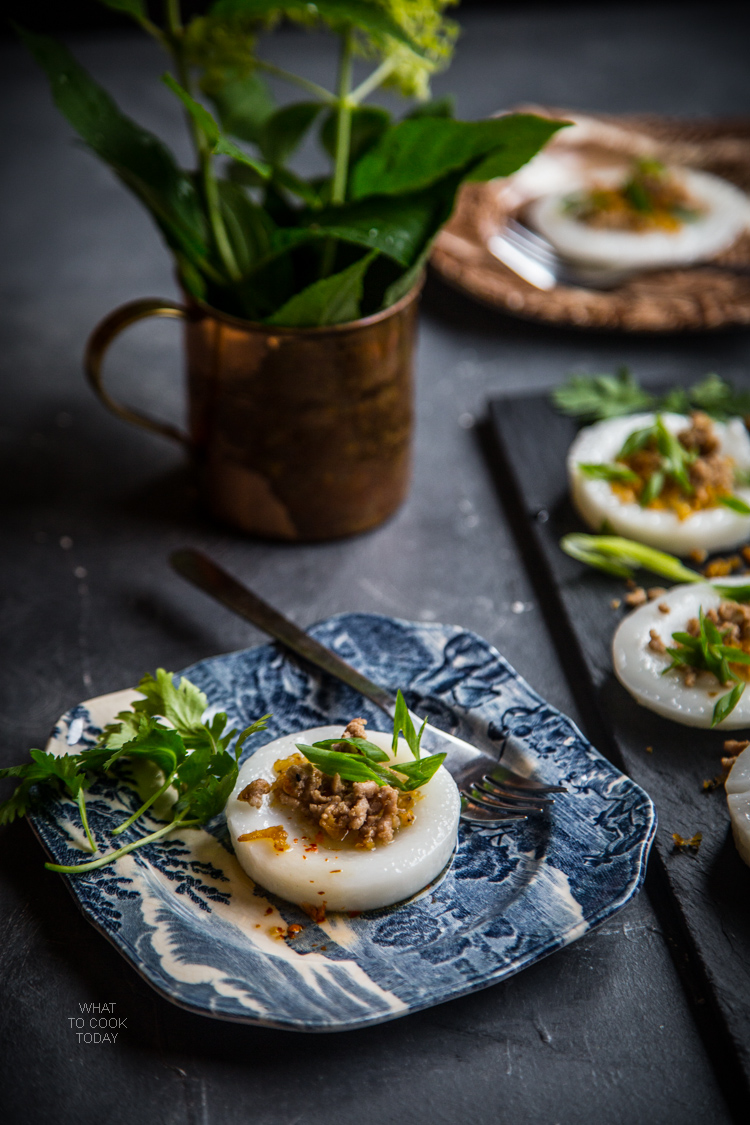
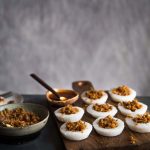
40 comments
Hi Marvellina, can i subs the tapioca flour with almond flour and rice flour to make chwee kueh? 🙂 Thank you 🙂
Hi Mei, I’m sorry that I haven’t tried it with those flours, so I can’t tell you for sure if the chwee kueh will turn out or not! If you do end up trying them, I would love to know how it turns out!
good suggestions. tq
I tried the chew kueh recipe. It is super super good and the method is very easy to follow. The cheese kueh turn out much better than the one from hawker stall. Thanks a million. Thank you for sharing your wonderful receipe. May God Bless you!
So glad the recipe worked out for you Sarah! 🙂 Thank you for taking time for letting me know. It meant a lot!
First time making chwee kueh and all family members like them. I made two batches using the two recipes you share, some preferred the recipe for version 1 and some preferred the recipe for version. I found the recipe for version 1 is softer than version 2, version 2 hold its shape when is taken out from the ramekin. Both recipes are just as good !
Many thanks for the recipe
Hi SW, I’m glad the chwee kueh turns out great for you. Yes, it’s a matter of preference I guess in terms of the texture 🙂 Thank you for your feedback 🙂
I hope its not too late to ask a question. Following your recipe and cooking method using rice and tapioca flours, the top portion of the chew kuay was perfect with firm surface but the bottom of the chwee kuay was soft and soggy. How to avoid this problem?. Appreciate your advice.
It sounds like it may need additional cooking time. Try to steam it a bit longer and that should fix the soggy issue.